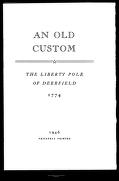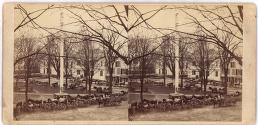|

"An Old Custom" -The Liberty Pole of Deerfield 1774

"Bloody Butchery, By The British Troops; Or The Runaway Fight Of The Regulars"

Boston Tea Party Report

Liberty Pole

Engraving "The Bloody Massacre perpetrated on King Street, Boston on March 5th, 1770"
|
Summary and Objective
This simulation exercise entails erstwhile mobs of Tories and Whigs, each represented by their counsel, and each pleading their case before Sir John Wickliffe, emissary to King George. After an impartial panel from another classroom has heard the testimonies, Sir John will take its recommendation to the King of whether or not the colonies should be granted their independence. Students will understand that both Loyalists and Whigs had legitimate perspectives.
Teaching Plan
Step 1.
Pre-activity: This activity works well as a culmination project for the study of the steps leading to the American Revolution. As a class, define "Whig" (or "continental") and "Tory" (or "loyalist") and describe the perspective of each. The class will explore whether or not the King should grant independence to the colonies. Together, brainstorm and list reasons and problems both for independence for the colonies and for remaining loyal to the King. As a model for Step 2, together view "Boston Tea Party Report" from the digital collection, including how to read the label and to use "view text." Brainstorm and list the reactions and opinions of both Whigs and Tories. Then add to the list already brainstormed.
Step 2.
Pre-activity: Split the class into two groups, one Tory and one Whig. Form them into pairs, each consisting of one Whig and one Tory. Have each pair view one of these items from the digital collection: "An Old Custom: The Liberty Pole of Deerfield" along with viewing "The Liberty Pole," "Boston Tea Party Report," and "Engraving of 'The Bloody Massacre.'" The students each take notes of the views expressed in the item, according to the student's perspective as a Tory or Whig. Add these to the list brainstormed earlier.
Step 3.
Pre-activity: If time permits, use the "further websites" listed below, and other reference materials to better understand both sides of the issue.
Step 4.
Present to the class that the setting is 1774 Boston. The city is abuzz with the question, "Should the King grant the colonies independence?" The class will be conducting a hearing using citizens of Boston playing the roles of Tories, Whigs, and their counsels. Another class will be invited to play the role of an impartial "'panel" of citizens who will hear the testimonies, with Sir John Wickliffe, emissary to King George, presiding.
Step 5.
The Tories and Whigs will each convene as a group and prepare for its part in the hearing. Each group will select its counsel, and plan and organize its testimonies and opinions. Each group will also plan the questions that should be asked both of themselves and of the opposing side's witnesses during the hearing.
Step 6.
An adult, such as the classroom teacher, will serve as Sir John, and any member of the class will serve as bailiff. The hearing will commence with the bailiff asking the court to rise. Lord Wickliffe enters. The bailiff will then ask the court to be seated. He or she will introduce the protocols:
"All questions or answers directed to Lord Wickliffe will include 'my lord' or 'm'lord'. To begin each testimony the counsel must first ask the witness his or her name, residence and occupation [to have been determined beforehand]. If any members have additional comments or questions, they must be directed through the member's counsel. Only the counsels will have the opportunity, therefore, to address either the witnesses or Lord Wickliffe."
Step 7.
Each side will present its "case" with opposing counsels being able to question (i.e. cross examine) the opposing group's witnesses.
Step 8.
At the conclusion to the hearing, members of the imparial panel will discuss their conclusions and vote on their recommendation to the King. Lord Wickliffe will thank the participants, promise to relate the panel's recommendation to the king and end by proclaiming, "God save the King!"
|




